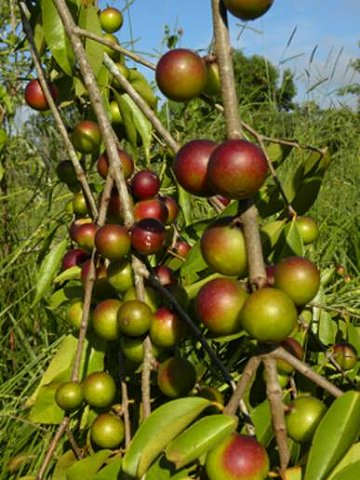
|
|
Camu Camu (Myrciaria dubia).
Leaves and fruits.
|
Camu Camu -
Myrciaria dubia
Myrciaria dubia, commonly known as camu-camu, camucamu, caçari, araçá-d'água, or camocamo, is a species of plant in the family Myrtaceae. It is a small bushy riverside tree from the Amazon rainforest in Peru and Brazil, which grows to a height of 3–5 m (9.8–16.4 ft) and bears a red/purple cherry-like fruit. It is a close relative of the jabuticaba (Myrciaria cauliflora) and the guavaberry or rumberry (Myrciaria floribunda). As much as 2-3% of the fresh fruit by weight is vitamin C.
Camu-camu has small flowers with waxy white petals and a sweet-smelling aroma. It has bushy, feathery foliage. The evergreen, opposite leaves are lanceolate to elliptic. Individual leaves are 3–20 cm (1.2–7.9 in)m in length and 1–2 cm (0.39–0.79 in) wide.
The camu-camu fruit is maroon or purple-black when fully ripe, around 25mm in diameter, with either sweet or acidic flesh.
The current range of camu-camu consists of the Amazonian lowlands of Colombia, Ecuador, Peru, Bolivia, and Brazil. Its distribution extends from the center of Pará state, Brazil, along the mid and upper Amazon River to the eastern part of Peru; in the north, it appears in the Casiquiare and the upper and middle Orinoco River. In Brazil, it is found in Rondônia along the Maçangana and Urupa Rivers and in Amazonas, in the municipalities of Manaus and Manacapuru and along the Javarí, Madeira, and Negro Rivers.
Long used by native peoples, wild camu-camu fruit is harvested directly into canoes. The fruit has only recently come into large-scale cultivation and sale to the world market, with Japan being the major buyer. The tree is relatively easy to cultivate within certain growing conditions. It survives best in hot, damp, tropical climates, but will grow in the subtropics, surviving temperatures down to just above freezing. It requires copious water.
Camu camu is used mainly for its edible fruits. The tree occurs in locally dense populations (1000/ha) or even monospecific stands in Amazonian flood plains and riparian vegetation. The plant is extremely tolerant of flooding, withstanding 4 to 5 months with the roots and even much of the aerial parts submerged in water. The species propagates through botanical seeds. In cultivation, the tree begins bearing fruits after attaining 2 cm in stem girth (three years after emergence of the seedling). Harvests are seasonal and occur once per year, in synchrony with the annual cycle of precipitation. Plants flower at the end of the dry season and fruit at the peak of the rainy season. Observations with both wild and cultivated plants suggest that trees can remain productive for several decades.
Documentation of traditional Camu camu uses is scarce. It is unlikely that in traditional Amazonian societies Camu camu has ever been nutritionally relevant. The fruit is extremely acidic, and the flavour can only be appreciated in recipes requiring a blender, dilution in milk/water and the addition of sugar.
Camu camu has an extraordinarily high vitamin C content (in the order of 2-3% of fresh weight, second only to the Australian native Terminalia ferdinandiana) and is the most important property of the Camu camu fruit, which has been exploited consistently in positioning Camu camu on international markets.
It has over 20 times more vitamin C than most citrus fruits. Vitamin C content declines as full maturity is reached, and there is a trade-off between vitamin C and flavour expression. As a myrtaceous fruit, Camu camu most likely provides other nutritional benefits, but these are less understood and communicated to consumers.
Camu camu has also a unique aroma and fruit pigmentation. A reddish pigment in the leathery skin (probably anthocyanins) imparts an attractive and unique pink color on juices extracted from Camu camu. The aroma is subtle, but is not as captivating as in more popular fruits. Camu camu is more recently also used in ice creams, sweets, etc.
Processed powder from the fruit pulp is beginning to be sold in the west as a health food in loose powder or capsule form. In addition to the high vitamin C content it contains the amino acids valine, leucine and serine.
It is also rich in flavonoids, such as anthocyanins, flavonols, catechins, delphinidin 3-glucoside, cyanidin 3-glucoside, ellagic acid and rutin; other analysis revealed the presence of gallic and ellagic acids, suggesting that Camu camu fruit possesses hydrolyzed tannins (gallo- and/or ellagitannins).
Source:
https://en.wikipedia.org/wiki/Myrciaria_dubia
https://en-academic.com/dic.nsf/enwiki/256178
